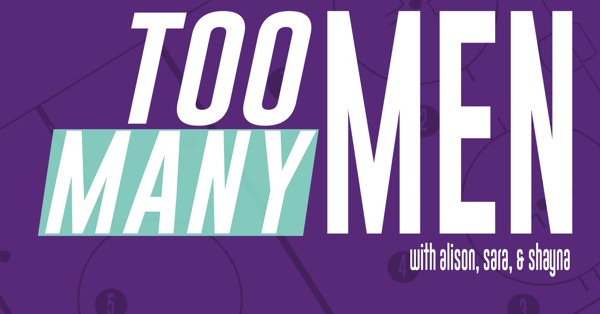What Happens When Alison Lukan Finds Her People
Learn more about one of hockey journalism's most dynamic and creative communicators
Whereas most college students with school spirit might buy branded apparel and show up at events to cheer on teams, Alison Lukan decided to don the spider mascot costume at the University of Richmond for two years after trying out on a whim as a sophomore.
While many individuals will cut a check and maybe run five kilometers to support their local Komen Race For The Cure, Lukan took on the role of Race Chair for the annual event in Columbus, Ohio, where she organized and executed plans that affected thousands of runners and raised millions of dollars for breast cancer research.
And although many hockey fans with an interest in analytics are content to check their favorite data websites and read a few number-heavy articles each week, Lukan became a regular on the conference circuit and later co-created and co-hosted analytics-oriented events in Columbus in February and online during the pandemic.
Lukan also finds time to write for a living.
Armed with an abundance of initiative and intelligence, Lukan seamlessly shifts between conversations with media members, statistical modelers, everyday fans, and NHL players. The hockey community is lucky to have such a dynamic and dedicated communicator in its corner. Lukan turns that notion on its head, though.
"When I think about my personal experience, I’m nowhere even close to not only doing what I do, but having the opportunities that I’ve had without a community that welcomed me without judgment...always willing to help me and teach me and coach me," said Lukan, who joined The Athletic in 2017 to cover the Columbus Blue Jackets.
"When I find my people, I’m fiercely protective of them, and I want them to have nothing but success, so I will stand up for them and encourage them and put together a conference for them to speak. I will celebrate them. … Sometimes my protectiveness of others gets me in trouble, but it is one of the biggest things that I’m all about.”

"The culture is what perseveres"
Though Lukan eventually traveled to hockey analytics conferences on each coast, as far north as Ottawa and as far south as Florida, she started her tour with a short trip to Pittsburgh in 2014 for the War On Ice event at Carnegie Mellon University.
Covering the Blue Jackets on a part-time basis, Lukan considered herself "a nobody" in the analytics scene as she took her seat in the auditorium that day, she said.
When Matt Cane -- now Director of Hockey Analytics for the New Jersey Devils -- sat down nearby after presenting research, Lukan leaned over and shared a few kind words. Cane not only received the praise warmly, he kept the conversation rolling along, appreciative of Lukan's enthusiasm and unfazed by her lack of math expertise.
Lukan's spirits soared even higher when she chatted with Jen Lute Costello, a presenter and one of the most prominent women in hockey analytics at the time.
The conference newcomer enjoyed the subject matter in Pittsburgh. She loved the culture more.
Her calendars became dotted with conference dates during the years that followed.
"These people became my real friends," Lukan said. "We know (hockey analytics) gets a bad rap sometimes, so part of the goal for conferences is disproving the stereotype of the nerdy jerk in a white tower saying 'You don’t believe in stats, so you suck.' … The analysis work is always going to change. The culture is what perseveres."
Just before February's Columbus conference, Lukan published a story in The Athletic on the history of the "HAC," which she traced back to an event in Calgary in 2014. Her article detailed the slight differences between the conferences hosted in eight cities -- a subtle nod to the inventory of ideas she used to set the standards for Columbus' event.
"When you change careers like I did," said Lukan, who previously worked in corporate consulting, "I think sometimes other people will look at what you’ve done, and they’ll say, 'What are you doing? You were doing A, and then you’re doing C, and now you’re doing Q. What’s the point? Do you even know what you want to do with your life?' And this was one of those rare moments where A, C and Q all lined up to help guarantee success, and that was a rewarding feeling for me."
"There are people who don’t want the measurables"
Glimpses into Lukan's corporate consulting life, which spanned two decades, still exist on the internet via blogs and a webinar on process mapping.
One could argue only the industry jargon and audience demographics changed when Lukan traded conversations with telecom execs, financial advisors and law firms for interviews with NHL personnel. Her objectives held fairly steady.
"As a consultant, I had to find tangible, measurable ways to tie behaviors to every goal, which people could buy into and believe were real, because the behaviors were in fact real," Lukan said. "That thought process positioned me to do what I do now.
"Hockey turned the tables on that, in the sense that there are measurables, but there are people who don’t want the measurables."
Lukan fully supports fans who want their sports sans technical analysis, and she welcomes the opportunity to educate those who have questions. She also stands by a belief common among NHL coaches: Players only need to grasp the underlying concepts that analytics address -- they don't need to digest the metrics.
That's why her questions to players and coaches are far from math quizzes.
"My challenge is to take a statistical or analytical revelation or concept and turn it into talk that relates to how players and coaches think the game," Lukan said. "For me, I love the challenge, because it means I have to know what I’m talking about. I hate not knowing what I’m talking about. If I’m going to go ask Seth Jones about puck retrievals or shot assists, and he will push back and ask whether I’m talking about this or this, I have to be able to answer that question. I love that translation factor.
"What I love about it too is the reverse validation. The analytical community can say we can measure this, and it relates this way, and it’s predictive or correlated. Sometimes I take that concept into a room and everyone says yeah, it totally matters in a game. And sometimes players or coaches will say they see what I’m saying, but that’s not at all how they think about it.
"I think that reverse validation is just as fascinating, and we who think in numbers have to hear that as well. It doesn’t make the numbers invalid, but if we’re really working in this game, we have to understand that interplay too, because there’s so much we can’t measure right now. That validation and translation is some of the most fun I have when I’m doing my work.”


"I don’t want to be just the analytics person”
Lukan is not one to live vicariously through her sources.
She started playing pickup hockey around the same time she began writing about the Blue Jackets. Her intent: Experience the physical and mental demands of the sport firsthand.
Lukan developed the ability to code in R and manually track puck movements in games a couple years after attending her first few analytics conferences because she hated leaning on friends for favors and wanted to improve her own productivity as an analyst.
Learning more about statistics and probability is still on the to-do list, but she has a project in mind.
Ample evidence suggests none of these endeavors are necessary to advance in sports media. Most beat writers and broadcasters get by with little to no analytical lens, and NHL trade rumors usually don't gravitate toward data-driven reporters.
Such skill development unfortunately creates the potential for journalism pigeonholes, a reality not lost on Lukan.
"I like my niche," she said, "but I also have to always challenge myself and not get frustrated when I see others stick me in that pigeonhole versus saying there’s more I can do. I don’t want to be just the analytics person.”


Mixing metrics into stories remains an unproven strategy for becoming a media star, but Lukan is optimistic about the potential for analytics to address some of hockey's most pressing questions.
"Much like in the business world, hockey can still be very objective," Lukan said. "We can look at how many black children are in your youth hockey programs. How much money are you giving to provide opportunities to children from low-income communities? How many jobs and internships in your organization are you giving to people from currently under-represented communities?
"If we can look at all of that from a purely statistical and analytical perspective, it takes the subjectivity out of it, period. And that’s perhaps one of the most necessary ways to look at such an understandably emotional and sensitive topic on many ends of the spectrum. The data can be our friend here, and I’d love to see all of us use our skills, particularly our analytical friends, to change the nature of our culture, not just in hockey but pretty much all walks of life right now.”




Alison is the epitome of what a modern hockey journalist should be. She's even a better person than a journalist.
Such a wonderful article. It didn’t even cover all the time and effort Alison put into helping organize “CANNONFEST” (annual fan gathering in August). I have some great memories attending those and interacting with other CBJ super fans!